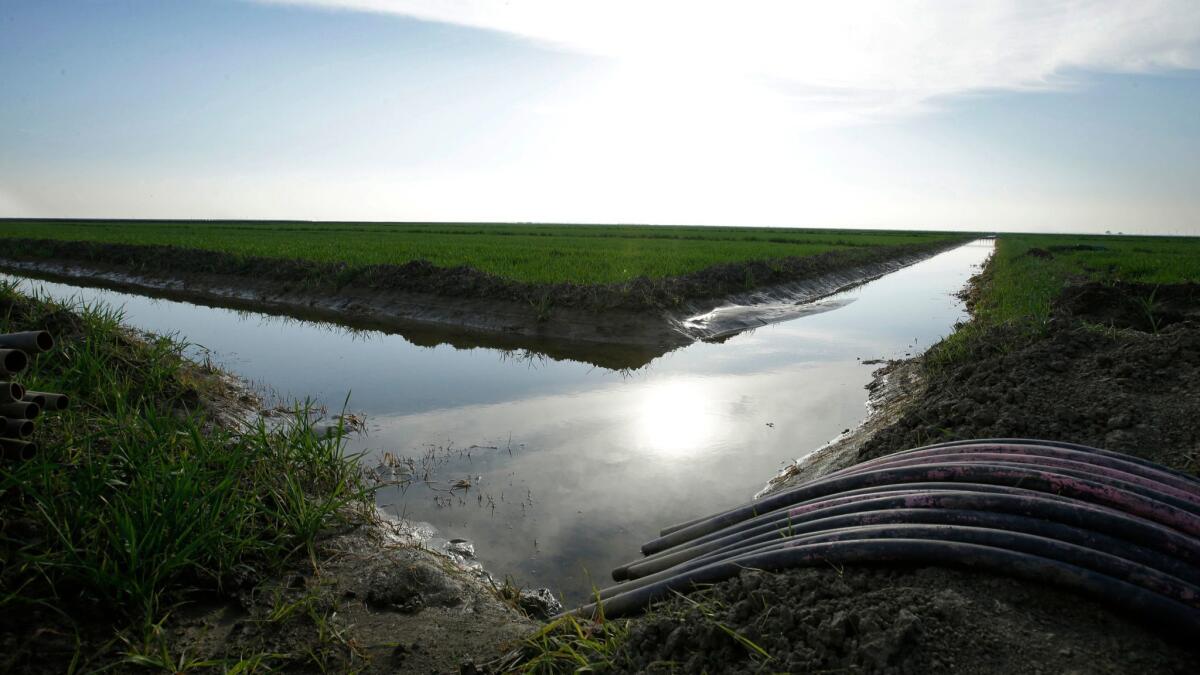Op-Ed: How do we detoxify California’s poison tap water? More democracy

The public water boards in the southern San Joaquin Valley are only nominally public. Of 565 water board seats in Fresno, Kern, Kings and Tulare counties, 491 — a stunning 87% — went uncontested in elections over the last four years, according to the Visalia-based Community Water Center. Candidates ran unopposed so often that three-quarters of the boards didn’t even bother to hold elections.
These boards are the closest thing to local government in more than 300 unincorporated communities in the water-scarce San Joaquin Valley. They manage delivery of drinking water to residents and water to farms and dairies. They fund investments in pumps and pipes, set water rates and collect fees, and in some cases manage groundwater consumption.
Most pertinently, they are responsible for water quality in agricultural communities where chemical runoff and naturally occurring contaminants such as arsenic have poisoned wells. As a result, a million or more Californians, most of them living in poor farmworker communities, can’t safely drink the water that comes out of their taps.
As Laurel Firestone, the Community Water Center’s co-executive director, explained to me, local water boards have the potential to change that, particularly if board members are drawn from the communities that are directly affected by the boards’ decisions.
Unfortunately, as the San Joaquin Valley study showed, few boards meet that criterion. Instead, power gets concentrated in the same set of hands over time, often district “good old boys” — older white males who may not even live where water quality is the worst.
The story of West Goshen, an unincorporated town of 500 or so mostly Latino farmworkers and their families in Tulare County, shows both the harm that unrepresentative boards can do and the benefits of invigorating them.
A million or more Californians, most of them living in poor farmworker communities, can’t safely drink the water that comes out of their taps.
Until 2007, most West Goshen residents didn’t even know that an elected local water board existed. Then the board, in the form of the West Goshen Mutual Water Co., quadrupled their water rates.
It turned out that a single family had run the board and the company for more than a decade, according to Lucy Hernandez, a West Goshen resident who led opposition to the incumbents. West Goshen homeowners should have been voting regularly for those who oversee their water, but partly because of the board’s obscurity, the members never faced opposition; they skipped elections. The board held “public” meetings that community members didn’t know about. “Father, wife, son, niece — it was like a family business,” Hernandez told me.
The rate increase, which was triggered by the need to repair a broken pump, provoked a community revolt. When new board members took over, West Goshen applied for state grants and received money to fix the pump.
But the system’s problems weren’t over. A few years later, tests showed West Goshen’s water was contaminated with nitrate from agricultural runoff. Residents could use their tap water, risking health problems from diarrhea to cancer to death, or they could spend a sizeable portion of their scant incomes on bottled water.
Again the board applied for state grants, this time $3 million, so that its constituents could be hooked up to the robust water system in the neighboring city of Visalia. Not only was West Goshen’s drinking water made safe, but the town’s rates dropped by half or more because it was sharing costs with Visalia.
West Goshen’s success story stands for the crucial work water boards do at the local level. But Firestone believes such grassroots water activism will also have an impact on statewide water policy. Not least because their members often move on to seats on regional water boards, where their power multiplies.
Here’s an example of what’s at stake. Gov. Jerry Brown’s current budget includes provisions for a Safe and Affordable Drinking Water Fund, which would provide money to fix tainted drinking water systems throughout the state — its approval would constitute one of Brown’s most important accomplishments. Payments for the fund would come from farmers, as a way of resolving their legal responsibility for the water contamination caused by agricultural chemicals, and from a 95-cent monthly fee on municipal utility users’ water bills (with low-income residents exempted).
Farmers, environmentalists and water-stressed communities support the fund. The primary opponent is the Assn. of California Water Agencies, a statewide coalition of 448 public water agencies. Timothy Quinn, ACWA’s executive director, told the Sacramento Bee last week that a problem caused largely by farming shouldn’t be solved “by putting a charge on somebody’s bill in Los Angeles or San Diego or San Francisco.” Given that approval requires a two-thirds vote of the Legislature, ACWA’s opposition could prevent passage of the measure.
ACWA’s position “shows how disconnected many water agencies are from the communities within their own jurisdictions,” Firestone said. With more local representation on the water boards, the agency’s stance could change.
The Community Water Center has held workshops in unincorporated communities to explain the water boards’ significance and the opportunity to run for seats. Some residents have felt too intimidated to run, so the center has established a “water leaders” network for current and newly elected board members to share information and support.
The benefits are obvious. Sham democracy gets replaced with the real thing, and we get that much closer to making good on the human right to clean water for hundreds of thousands of Californians.
Jacques Leslie is a contributing writer to Opinion.
Follow the Opinion section on Twitter @latimesopinionand Facebook
More to Read
A cure for the common opinion
Get thought-provoking perspectives with our weekly newsletter.
You may occasionally receive promotional content from the Los Angeles Times.






